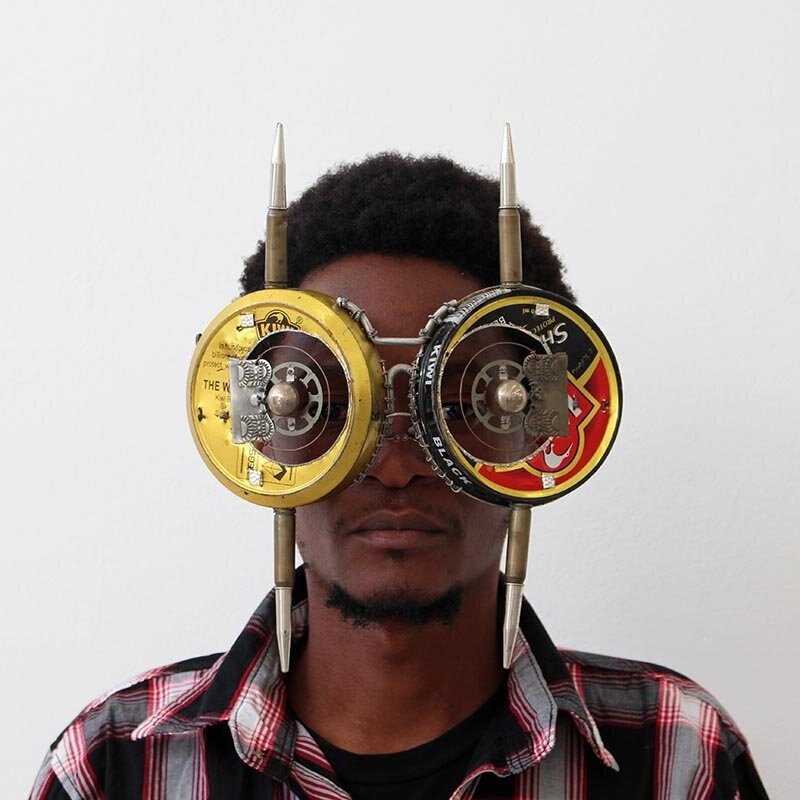Early Childhood Art Inspired by Cyrus Kabiru's Afrofuturist C-Stunners
By Marla McLean
This year as a school, we are focusing on elevating Black joy, excellence, and culture through living people throughout the African diaspora. And while this is a project we are digging into in February and March, Black joy is intended to be a provocation for continued expansive teaching practice and curriculum development at School Within School @ Goding as a core principle.
As the Early Childhood Atelierista (working virtually yet live with the children), I am centering our Black joy projects around Afrofuturism.
From the essay “Afrofuturism Has Always Looked Forward: How can the ideology serve as a blueprint for cultural growth?” by Taylor Crumpton:
For the uninitiated, Afrofuturism is a fluid ideology shaped by generations of artists, musicians, scholars, and activists whose aim is to reconstruct “Blackness” in the culture. Reflected in the life and works of such figures as Octavia Butler, Sojourner Truth, Sun Ra, and Janelle Monáe, Afrofuturism is a cultural blueprint to guide society. The term was coined by Mark Dery in 1993 but birthed in the minds of enslaved Africans who prayed for their lives and the lives of their descendants along the horrific Middle Passage. The first Afrofuturists envisioned a society free from the bondage of oppression — both physical and social. Afrofuturism imagines a future void of white supremacist thought and the structures that violently oppressed Black communities. Afrofuturism evaluates the past and future to create better conditions for the present generation of Black people through the use of technology, often presented through art, music, and literature.
For the Black Lives Matter at School Week of Action, we began by being inspired by the vision and genius of Cyrus Kabiru.
The PreK children were spellbound listening to and watching Cyrus speak and create through shared videos.
“I grew up surrounded by a lot of trash,” says Cyrus Kabiru. “The biggest dumpsite in Nairobi was right opposite my house. I used to tell my dad, 'When I grow up I'll give trash a second chance.' I used to feel like trash also needs a chance to live.”
After looking at Mr. Kabiru’s glasses (C-Stunners, as he calls them), glasses no one had ever imagined before, I explained how he is called an Afrofuturist. He is an artist from Kenya who creates art that no one in the world has ever seen before, he creates by making a new and better future, where trash is given a second chance. All of his C-Stunners also tell a story. Each one is different. He is a creative genius.
Children’s responses were through making. As they created, I played music from an Afrofuturism playlist I created of SunRa, Janelle Monet, Laura Mvula, Sister Rosetta Tharpe, Kamasi Washington, Erykah Badu, Valerie June, and more. The sensory and delight of the creative process was compelling to observe. I could see all the squares on the video where children were dancing or experimenting, constructing and creating, all while centering the Afrofuturist ideals of Cyrus Kabiru.
Next week, I have asked children to bring their Stunner creations back. We will look at Cyrus Kabiru’s mixed media paintings of C-Stunners on himself. PreK children will engage in a new kind of mixed media making, connected to the glasses. Like Cyrus, I will ask them to imagine a new and better future and tell a bit of their story.
As we further explore and co-construct this project inspired by Afrofuturism, I will tie in many books, such as Milo's Museum, and the illustrations and stories of Christian Robinson and Beautiful Blackbird by Ashley Bryan.





